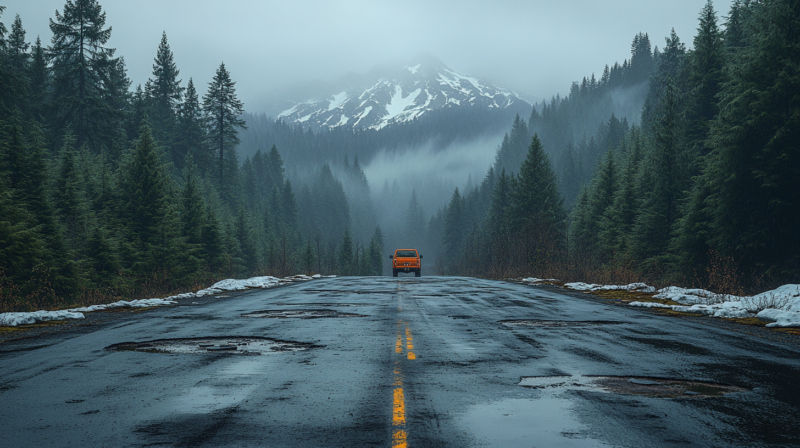What hikers, campers, and road trippers need to know before the rubber hits the road.
Spring brings a rush of adventure to the Pacific Northwest. Trailheads thaw, lakes shine, and passes like Snoqualmie and Santiam become lifelines to the wilderness. But while snow may melt off quickly, the damage it leaves behind doesn’t vanish with the sun. From frost-heaved pavement to crater-sized potholes, road maintenance is a major part of the spring story in both Washington and Oregon.
So if you’re planning to drive deep into the Cascades this spring, ask yourself: How’s the road beneath me holding up?
We’ve scoured reports from WSDOT, ODOT, and real-world driver accounts to give you a ground-level look at the state of repair across top PNW forest passes. Because while nature stuns up top, it’s the pavement down low that gets you there.
Spring 2025: The Road Repair Reality
Why Are Roads in Rough Shape Right Now?
Heavy snow and rain in late winter 2024–2025 did a number on the pavement. Freeze-thaw cycles widened existing cracks and created new potholes, particularly on older rural roads and trailhead turnoffs. While major highways like I-90 and I-5 were plowed regularly, that same machinery often scrapes asphalt and accelerates wear.
Both Washington and Oregon are in catch-up mode:
- WSDOT patched over 16,000 potholes last year in 2024 and expects similar numbers in 2025.
- ODOT faces a $1.8 billion shortfall, which means fewer crews and delayed non-emergency repairs, especially on secondary routes.
As of April 2025, the focus is on patching, crack sealing, and shoulder stabilization—not full repaving. So, even if a road looks smooth, it might still be a temporary fix.
Washington: WSDOT Holds the Line—Barely
Snoqualmie Pass (I-90 Corridor)
- Maintenance Focus: Crack sealing and shoulder work underway; 2024 bridge rehab is complete.
- Problem Areas: Off-ramps and trail access roads (like those leading to Snow Lake) remain rough. Snowmelt reveals new potholes every week.
- What to Expect: Smooth cruising on I-90 proper, but jarring hits on service roads unless patched recently.
Stevens Pass (US 2)
- Maintenance Focus: Spot patching in progress, especially after plow damage.
- Problem Areas: Forest Service roads near Coles Corner and Lake Wenatchee are cratered. US 2 itself is hanging in there.
- What to Expect: Highways are passable, but rural routes lag due to budget and staffing constraints.
North Cascades (SR 20) & Chinook Pass (SR 410)
- Maintenance Focus: Still in snow-clearing phase. Once plows finish, pothole repair crews follow.
- Problem Areas: Trailhead parking lots and shoulder pullouts tend to be lowest priority.
- What to Expect: May openings will bring smoother main routes, but early hikers should prep for muddy, uneven pull-ins.
Oregon: ODOT’s Uphill Battle
Santiam Pass (US 20)
- Maintenance Focus: Priority patching on key stretches; Blue Lake and Hoodoo access roads in rough shape.
- Problem Areas: Side roads near trailheads have “tire-eating” potholes per drivers.
- What to Expect: Highway itself is stable, but side-road maintenance is sparse due to ODOT’s funding gap.
Willamette Pass (OR 58)
- Maintenance Focus: Shoulder repair and drainage clearing to prevent washouts.
- Problem Areas: Turnoffs to ski areas and lakes (like Odell) suffer from broken pavement and soft edges.
- What to Expect: Decent ride on OR 58, but slow down when turning off—potholes come quick.
Tombstone Pass (OR 20)
- Maintenance Focus: Minimal. ODOT’s efforts here are reactive only—”fix it when it breaks” mode.
- Problem Areas: Crumbling pavement near Iron Mountain trail access, tight corners, and older asphalt.
- What to Expect: Drive with caution, especially if towing.
Siskiyou Summit (I-5)
- Maintenance Focus: South of Ashland got serious repairs in 2024; maintenance continues into 2025.
- Problem Areas: Ramps and offshoots near Ashland still show wear and need deeper fixes.
- What to Expect: Smooth ride across the summit itself—one of the rare “A+” spots this spring.
5 Maintenance Takeaways for Spring Road Warriors
- Main Highways First, Side Roads Last: WSDOT and ODOT prioritize interstates and state routes. Expect delays on rural fixes—especially Forest Service roads.
- Budget Cuts Hurt Everyone: Oregon’s road fund deficit and Washington’s crew shortages mean less manpower in the field. Be patient—and cautious.
- Temporary Patching is Common: Don’t mistake a freshly patched road for a smooth one. Quick fills often pop back out under heavy spring rain or snowmelt runoff.
- Drainage is a Big Deal: Many spring maintenance projects are aimed at clearing culverts and ditches, not fixing pavement. Standing water equals potholes in the making.
- Trailhead Turnoffs Are the Worst Maintained: Many of the worst reports—“gauntlet,” “crumbling,” “tire killer”—came from hikers and campers trying to reach remote access points. Slow down, or consider walking the last stretch in.
Drive Smarter This Spring: Tips from the Ground
- Use Real-Time Tools:
- WSDOT Travel Center
- ODOT TripCheck
These show camera feeds, ongoing maintenance, and closures—not just weather.
- Report What You See:
Your pothole report might actually get fixed faster:- WSDOT: Call 509-324-6566 or submit online
- ODOT: Call 1-888-275-6368 or visit Ask ODOT
- Gear Up Accordingly:
Bring a tire repair kit or portable compressor if heading off paved roads. And always check your spare—spring is pothole season.
The Roads Are Open—But Be Roadwise
Don’t let spring road damage derail your next PNW outing. Yes, the alpine lakes are thawing. Yes, the trails are calling. But if you’re not watching the road as much as the trailhead sign, you might get there on foot… with a flat tire behind you.
Stay updated, drive cautiously, and report damage when you see it.
Spring is for exploring—not for emergency tire changes.




